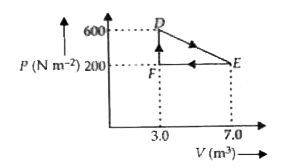A thermodynamic system is taken from an original state to an intermediate state by the linear process shown in Fig.
Its volume is then reduced to the original value from E to F by an isobaric process. Calculate the total work done by the gas from D to E to F.

Total work done by the gas from D to E to F.
W=WDE+WEF
= Area of trapezium DEGHD – Area of rectangle EFHG
= Area of triangle DEF
=12DE×FE
=12(600−300)Nm−2×(5.0−2.0)m3
= 450 J.
Topper's Solved these Questions
- THERMODYNAMICS BOOK - CBSE COMPLEMENTARY MATERIALCHAPTER - THERMODYNAMICS EXERCISE - MULTIPLE CHOICE QUESTIONS (MCQs)
20 Videos
- THERMODYNAMICS BOOK - CBSE COMPLEMENTARY MATERIALCHAPTER - THERMODYNAMICS EXERCISE - LONG ANSWER TYPE QUESTIONS (5 MARKS)
1 Videos
- ROTATIONAL MOTION BOOK - CBSE COMPLEMENTARY MATERIALCHAPTER - ROTATIONAL MOTION EXERCISE - MULTIPLE CHOICE QUESTIONS
20 Videos
- WORK, ENERGY AND POWERBOOK - CBSE COMPLEMENTARY MATERIALCHAPTER - WORK, ENERGY AND POWEREXERCISE - MCQ
20 Videos
Similar Questions
A thermodynamic system is taken from original state D to an intermediate state E by the linear process shown in figure.

Its volume is then reduced to the original value from E to F an isobaric process. Calculate the total work done by the gas from D to E and E to F.
View SolutionA thermodynamic system is taken from an original state D to an intermediate state E by the linear process shown in (figure)

Its volume is then reduced to the original value from E to D via F by an isobaric process. Calculate the total work done by the gas from D to E to F to D.
View Solution
Knowledge Check
A thermodynamic process is carried out from an original state D to an intermediate state E by the linear process shown in figure. The total work is done by the gas from D to E to F is
 A100 JB800 JC300 JD250 J
A100 JB800 JC300 JD250 JA thermodynamics process is carried out from an original state D to an intermediate state E by the linear process shown in figure, the total work is done by the gas from D to E to F is
 A100 JB450 JC300 JD250 J
A100 JB450 JC300 JD250 JA thermodynamic process is carried out from an original state D to an intermediate state E by the linear process shown in figure. The total work is done by the gas from D to E to F is
 A100 JB800 JC300 JD250 J
A100 JB800 JC300 JD250 J
A thermodynamic system is taken from an original state D to an intermediate state E by the linear process shown in (figure)

Its volume is then reduced to the original value from E to D via F by an isobaric process. Calculate the total work done by the gas from D to E to F to D.
View Solution
As shown in figure three paths through which a gas can be taken from the state A to the state B. Calculate the work done by the gas in each of the three paths.
View SolutionAn ideal gas change from state a to state b as shown in Fig. what is the work done by the gas in the process?

View Solutionshows three paths through which a gas can be taken from the state A to the state B. calculate the work done by the gas in each of the three paths.


View SolutionAn ideal gas change from state a to state b as shown in Fig. what is the work done by the gas in the process?

View Solution
